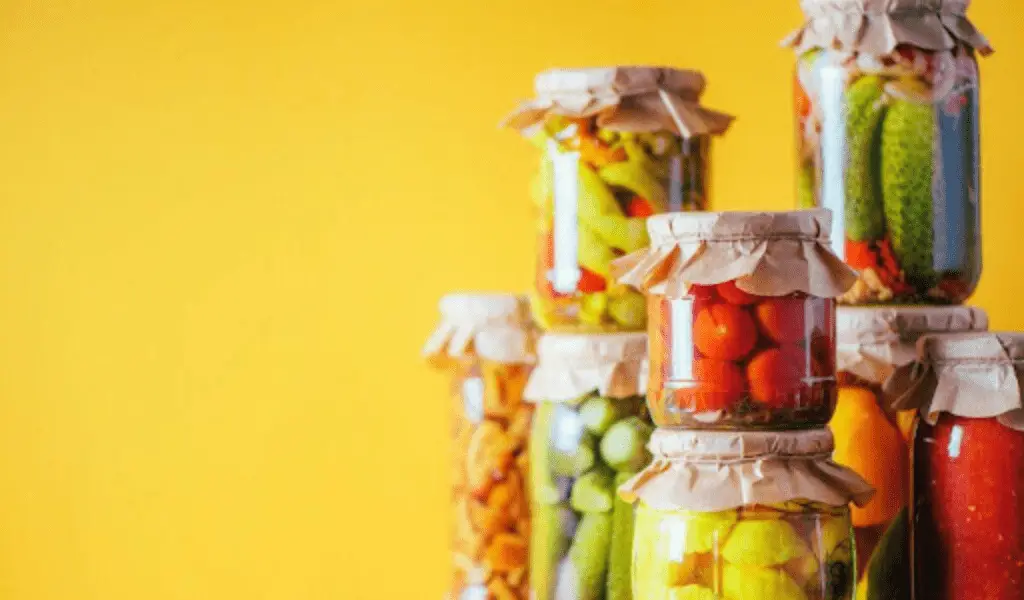
Ready to begin a culinary adventure of pickled proportions? You may think that pickling is just for cucumbers, but many corners of the globe pickle fruits and veggies of all shapes and flavors. So if you’re searching for a way to get into pickles, or searching for new pickling ideas, you’re about to find out just how adaptable the hobby can be!
In western culture, cucumbers are the most commonly pickled food, followed by cabbage and eggs. Napa cabbage is frequently used for kimchi, a popular South Korean pickling, and Japanese Nattō is made with soybeans. Mostarda is an Italian pickling made with fruits like figs, plums, or pears.
So forget cucumbers; if it’s a fruit or vegetable, it can be pickled. Let your taste buds explore the globe with our list of 11 of the most popular pickled vegetables and fruits from all corners of the world. We’ll also share the difference between pickling, fermenting, and canning, and then point you in the direction of a simple how-to pickle tutorial.
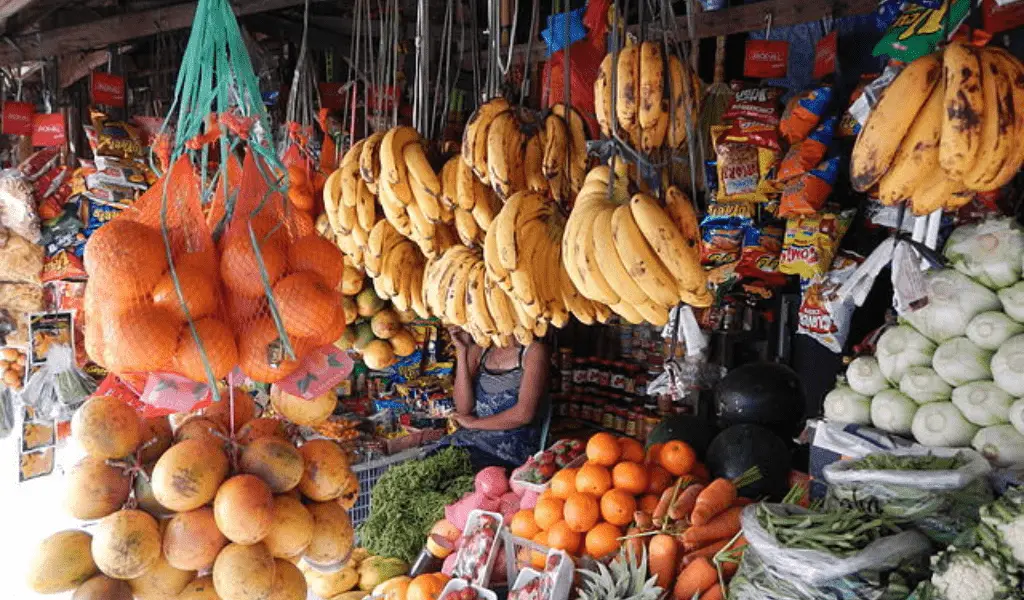
11 OF THE BEST VEGETABLES AND FRUITS TO PICKLE
We’ve all heard of pickled cucumbers, pickled onions, pickled radishes, etc. – but why not broaden your palate beyond a classic pickle with these 11 exotic pickles from around the world? Stretch your imagination with pickled fruit and pickled vegetables that you’ve never considered.
There’s something out there for everyone – so let’s take a trip around the culinary world and discover something new. Here are 11 new ideas that are sure to tickle your pickle.
1. Pickled Watermelon – Popular in Asia, Mexico, Guatemala, and Parts of Europe
Pickled watermelon and watermelon rinds are popular all over the world, just not so much in the United States. This one seems like a strange fruit to pickle – after all, it’s a big, sweet, and juicy fruit – why would you ever want to sour it? But, the more you think about it, the more it makes sense.
The tartness of the vinegar pairs well with the sweetness of the melon, making it a delicious treat. On top of that, store-bought watermelon is unpredictable: will it be a good one, or will it be too bland or too sweet? In our house, those are grounds for pickling.
Plus, watermelon is closely related to cucumber, a fact that you can nearly taste in some watermelon.
You can even pickle the rinds, making that often discarded part of the watermelon into a tasty and nutritious snack.
Click Here for a Pickled Watermelon Recipe
2. Pickled Napa Cabbage – Popular in South Korea
Who said you can’t pickle a leafy green? Napa cabbage is an incredibly versatile vegetable and the perfect choice for pickling. It has the crunch that you’d expect from cabbage, but with a flavor much milder than its cruciferous cousins.
Don’t jump to conclusions, though: this dish is nothing like sauerkraut. Kimchi can be sweet, spicy, salty, or sour, and maybe more than one of those at a time. Once it’s been pickled, its sweet and sour notes marry together perfectly, making kimchi and other Korean dishes some of the tastiest around.
While we are focusing on pickled cabbage instead of fermented cabbage, there are other ways you can approach this. Plus, there are so many different recipes to choose from: ginger-garlic-infused fermentations to chili-rich pastes.
A quick side note: many Asian cultures love pickled foods. You’ll find a tremendous amount of variety wherever you look. Thinks like pickled eggs, daikon radish, and many other uncommon combinations are pickled.
So while pickled napa cabbage is delicious with Korean fried chicken, you should also explore all that Asian cuisine can offer for pickling.
Click Here for a Pickled Napa Cabbage Recipe
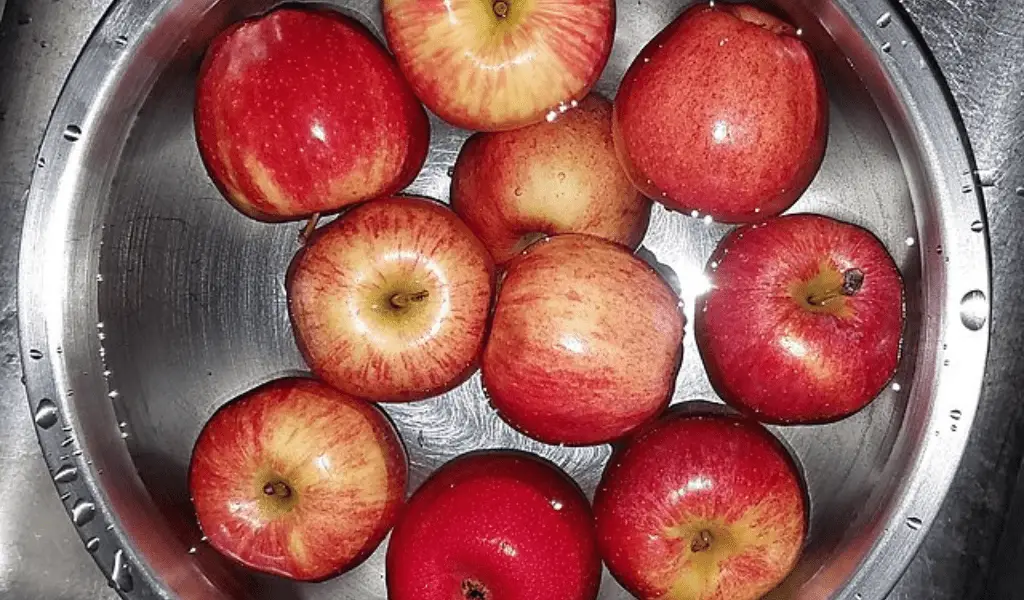
3. Pickled Apples – Popular in Italy and Ukraine
Move over cucumbers – apples are the real stars of pickling! Mostarda is an Italian condiment made with sweet-tart fruit, mustard, and spices that are traditionally served with meats. Mostarda is somewhat of a way of life where you pick any fruit that peaks at the end of the summer through fall, and apples fit the bill there.
To make Mostarda, you could use the classic recipe from Cremona, but there are plenty of variations on the web to explore, making this dish as versatile as you need it to be.
The juicy sweetness of apples is complemented by the tang of vinegar once you pickle them – this brings out fantastic flavors that you may not have thought possible.
You can do whole apples or slices, just know that whole apples will take longer to pickle because of their skin. Whether it’s a whole apple or slices, mostarda is the perfect way to elevate your pickled fruits from ordinary to extraordinary.
Click Here for a Mostarda Pickled Apples Recipe
4. Pickled Soybeans – Popular in Japan, Korea, China, Thailand, and Vietnam
For a truly unique dish, try Nattō, which is made by fermenting soybeans. The result is a dish of firm beans, stuck together by a substance of glutinous strings and having a strong yet pleasant smell of cheese.
You’re turning flavorful soybeans into an umami-packed delicacy. That description doesn’t sell it too well but trust us, they’re shockingly delicious and addictive.
Click Here for a Pickled Soybeans Recipe
5. Pickled Carrots – Popular in Germany, Netherlands, Denmark, Indonesia, and China
Carrots are an underrated vegetable and make for some very delicious pickles, combining their naturally sweet flavors with the tang of pickling. With recipes passed down through generations, there is no shortage of ways to pickle carrots. Look no further than how many different parts of the world pickle carrots – this delicacy covers many parts of Europe and Asia.
One dish that includes carrots that you should absolutely try is acar, a popular Indonesian pickle that also uses cucumbers and onions. It’s salty and spicy, and if you want to eat it traditionally, serve it over Indonesian fried rice.
It’s a perfect entry point for looking for some new pickling recipes since it straddles the traditional cucumber but also adds in new ingredients like our famed carrots. Plus, it’s quick and simple, it will be ready in a few days and you won’t need any special tools to complete it.
Click Here for a Pickled Carrots Recipe
6. Pickled Gherkins – Popular in Latin America and Asia
Ever heard of a gherkin? What about a cucamelon? What about the Mexican sour gherkin? Well, they’re the all same thing, and these small cucumber-like fruits are native to Latin America and perfect for pickling on a micro-scale.
They’re popular the world over and extremely versatile; from a classic pickling brine to unique Asian-style kimchi or red chili-infused ones, it’s easy to craft pickled gherkins right in your kitchen. They add a great balance of crunchy texture and tangy flavors to pickling and are also a great starting point if you want to be a little more adventurous than typical cucumber pickling.
Click Here for a Pickled Gherkins Recipe
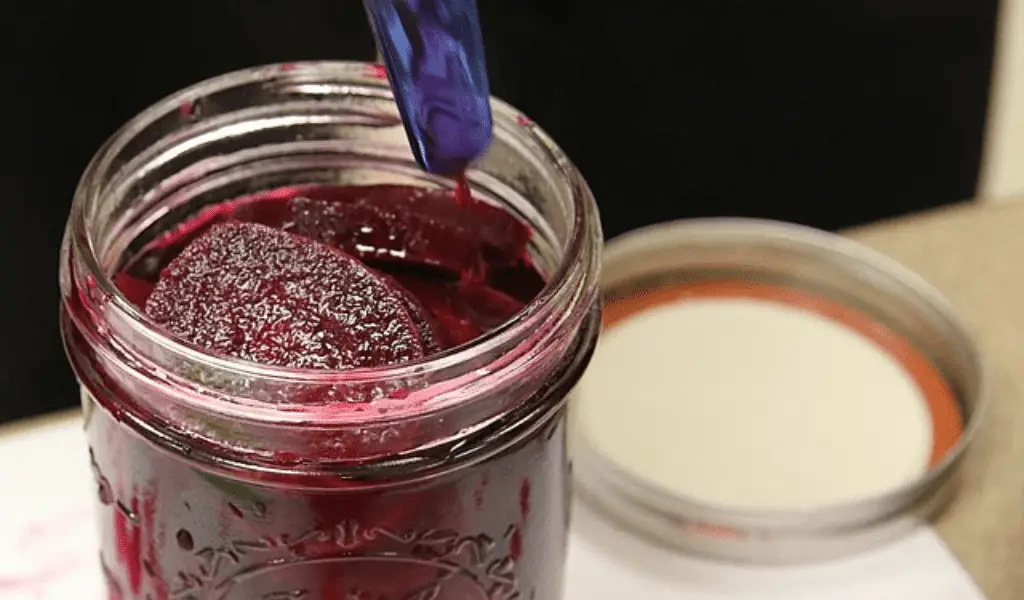
7. Pickled Beets – Popular in Eastern Europe, Latin America, and Central Asia
Pickled beets have a wonderfully sweet flavor and are sure to add a touch of color and flavor to any dish. This is an easy pickle as all you need is some fresh beets, vinegar, salt, and optional spices like red pepper flakes, mustard seeds, and kosher salt.
This pickle can be eaten warm or cold, and you can also add other types of vegetables to the mix like radishes, pickled onions, etc. They’re especially tasty when served alongside roasted meats or mixed into salads!
Beets are also a superfood and have a ridiculous amount of health benefits – whether raw, as beet juice, or even pickled beets, there’s a lot to like about this tiny red gem. So if you’re looking for a snack that is healthy and delicious, look no further than pickled beets.
Click Here for a Pickled Beets Recipe
8. Pickled Tomatoes – Popular in the Middle East, Mediterranean, and Southern Asia
Pickled tomatoes provide an intense flavor when added to salads, soups, stews, and other dishes. Think of them more as the sideshow to punch up the main act.
Tomato pickles from North India add an extra bit of flavor to their traditional dishes like dal or curries – we love this style which is why we’ve linked to an Andhra-style recipe below. Pickled tomatoes also work great for Mexican salsa recipes.
Tomatoes can be pickled using a variety of methods – from traditional brines or vinegar-based marinades to quick pickling or fermentation. You can also incorporate fresh herbs, spices, and other vegetables to customize the pickling process.
Pickled tomatoes are a great way to preserve the taste of the summer season even when it’s cold outside. Plus, they’re an easy snack with no cooking required.
Click Here for a Pickled Tomatoes Recipe
9. Pickled Limes – Popular in South Asia and the Middle East
Lime pickles are popular in Indian cuisine (nimbu ka achaar) and are especially good with a side of daal or curry. Unlike most other pickles, this is a sour and spicy mix that can be made sweet or salty depending on your preference.
This recipe involves quickly pickling the limes in a mixture of vinegar, sugar, spices like chili powder, fenugreek seeds, ginger-garlic paste, and mustard oil. The limes are then left to sit and marinate overnight, allowing the flavors to meld beautifully.
This is a great way to add a punch of flavor and texture to rice dishes or salads, as well as being an incredibly versatile condiment that can be eaten on its own or added to any dish for some extra zing.
Click Here for a Pickled Limes Recipe
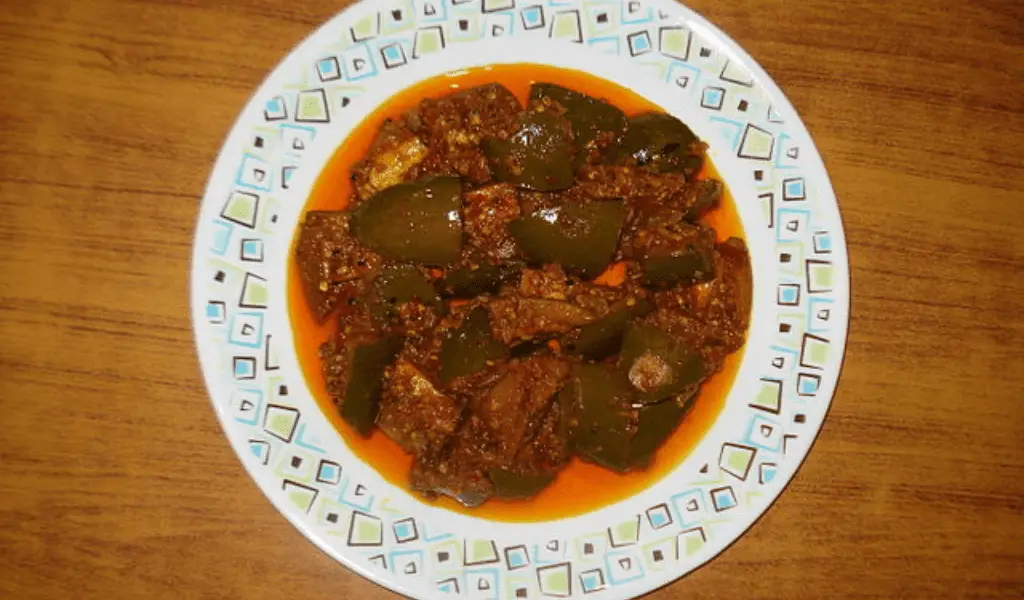
10. Pickled Mangoes – Popular in South Asia and the Middle East
Pickled mangoes, sometimes referred to as “achar” is a popular Indian pickle that adds a sweet-tangy flavor to food. India sure loves pickled foods, and we don’t blame them – we completely get it. This pickled treat is popular the country over, but we prefer the southern Indian style of preparing it.
Mangoes are marinated in a mix of vinegar, sugar, and spices like chili powder or fenugreek seeds before being pickled in jars. You can make mango pickles at home that will last for months if stored properly.
The process is simple and they’re great in a ton of different prepared styles, like sandwiches, salads, curries, chutneys, or our favorite way which is stirred into yogurt or cream-based sauces.
Click Here for a Pickled Mangoes Recipe
11. Pickled Peaches – Popular in the Southern United States
If you’re from the US, this one is going to hit closer to home since the southern states, especially Georgia are quite fond of pickled peaches. They capture all the great things of the south in a jar.
Spicy pickled peaches are absolutely the best and make for a killer topping on everything from salads to ice cream – they even make a tasty garnish for cocktails and bellinis. Plus, they are super easy to make yourself. Since we’re partial to the spicy version of pickled peaches, we’ll link to a recipe that hits it out of the park.
Click Here for a Spicy Pickled Peaches Recipe

WHAT’S THE DIFFERENCE BETWEEN PICKLING, FERMENTING, AND CANNING?
Pickling, fermenting, and canning are all methods of preserving foods to make them last longer, and though they tend to have a lot of similarities, they’re each distinctly different things. Some of the confusion comes from the fact that they all typically use glass jars, and some of the confusion comes from the fact that they don’t always happen separately.
Defining Pickling, Fermenting, and Canning
The easiest way to clarify the differences between them is to define the terms, so let’s start with that:
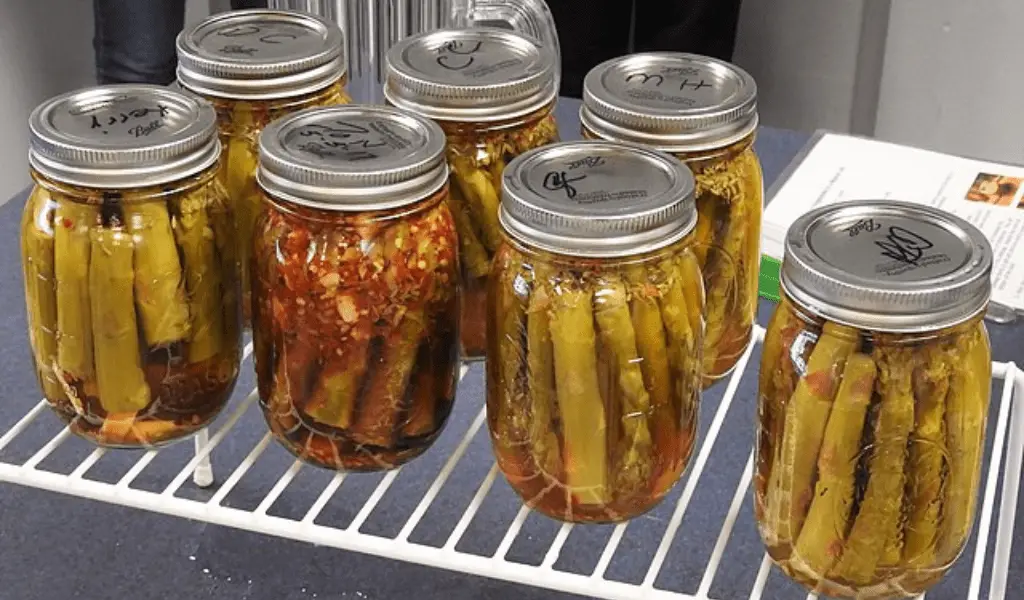
WHAT IS PICKLING FOOD?
Pickling is a method of preserving food by submerging it in an acidic solution or brine.
Pickling is a process that preserves food by immersing it in a brine that is one part acid and one part salty water. Vinegar is commonly used as an acid, but some recipes use lemon juice. The salt and acid act as preservatives by creating an environment hostile to harmful bacteria, keeping the food from harboring food-borne illnesses.
WHAT IS FERMENTING FOOD?
Fermenting is a process of breaking down sugars and starches with the help of natural bacteria and yeasts to make vinegar and alcohols. So instead of relying on a brine, fermenting instead uses probiotic bacteria, specifically Lactobacillus, to preserve the food.
This bacteria preserves the food by eating the sugars and carbs and producing lactic acid, which both flavors and preserves the food. This is also called Lacto-fermentation, and it enriches the food with beneficial probiotics and enzymes.
Fermenting is used in a wide variety – such as homebrewing and our favorite, kombucha. If you want to try your hand at the latter, be sure to check out our tutorial on brewing kombucha at home.
WHAT IS CANNING FOOD?
Canning is preserving foods in jars by heating them to high temperatures to kill microorganisms that may cause spoilage. In other words, canning sterilizes food with heat.
Once the jar is closed with the food inside, it’s put in a canner that heats the jar enough to kill any microorganisms inside.
The process also ends up sealing the jars so that no harmful germs can get in.
How Do You Choose Between Canning, Pickling, and Fermenting?
Now, a definition is well and good, but how do we apply that? How can we use that to tell the difference in practice? Well, the easiest time to make the distinction is when you have the recipe in front of you.
If the recipe calls for a brine with both an acid, water, and salt, then you’re likely doing some pickling. If it tells you to put the jars in a boiling water canner, then you’ll be canning. If you’re not canning, and the recipe doesn’t call for a lot of acids, then it’s probably fermenting.
But what if those variables intersect? If it might be one or the other, how do you tell which it is? Here’s where it might get confusing: it could be more than one.
You might be both canning and pickling, or you might be both pickling and fermenting. You’re not going to can and ferment the same thing, though, because the canning would kill the Lactobacillus.
For example, fresh-pack pickles are a type of pickle that is processed both with pickling and canning. The canning process kills all of the microorganisms, and the acid in the tangy brine or sour brine pickles the vegetables over the next few weeks.
Some quick-pickled foods are only pickled and not fermented, but many pickles are both pickled and fermented, including most cucumber pickles, sauerkraut, and kimchi. Foods that are both fermented and pickled rely on salt and acid to kill harmful bacteria rather than heat, allowing the Lactobacillus to survive and do its work.
IS PICKLING EASY TO DO?
With all this information in mind, you may be asking now if pickling is typically easy to do. Well, the answer is yes! Pickling food is typically considered pretty easy to do – and with the New Hobby Box tutorial on how to pickle foods, it couldn’t be easier!
The tutorial includes all the materials and supplies you need to pickle foods and even shows you where to get pickling kits in case you don’t want to retrieve individual items. It then walks you through every step of the process to pickle any type of fruit or vegetable at home.
It may seem like a difficult task right now, but with the proper tutorial, it’s not as difficult as it seems. And it’s certainly a rewarding effort.
